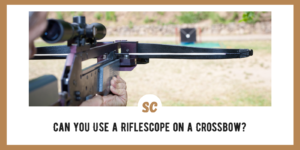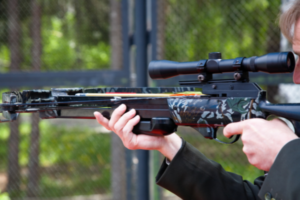You have your new crossbow and all the accessories. One thing missing is a scope, and you realize that you have a perfectly good riflescope in your gun safe. You wonder if you can use a riflescope on a crossbow?
It is possible to mount and use a riflescope on a crossbow. However, there are several differences between rifles and crossbows that may cause problems. Three problems that arise with riflescopes mounted on a crossbow are the scope’s recoil, the distance differences between rifles and crossbows, and the styles of reticles.
Many hunters do successfully mount a riflescope on their crossbow and have good results. However, manufacturers design riflescopes for rifles. Crossbows bring different challenges and require different specifications for scopes. Understanding these differences is the key to choosing the best scope for your crossbow.
What are the Differences Between Crossbow and Rifle Scopes?
Scopes for crossbows and rifles have a lot of similarities. Aside from the similar look for riflescopes and crossbow scopes, they tend to operate much the same. The overall goal is to bring the image of the target closer and make it larger to enable more accurate shooting.
Both types of scopes use the same technology to perform these functions. However, riflescopes and crossbow scopes face different types of stress and must include different features. Rifles and crossbows perform different functions that require different features from a scope.
Rifles and Crossbows: What Does a Scope Need to Do?
Let’s consider what rifles and crossbows do. Both are used for hunting, but they perform their duties in much different ways. The differences between a rifle and a crossbow help point out why scopes for rifles and crossbows need to be different.
Distances
Rifles are long-range firearms. Typically, rifles used for hunting have ranges from one hundred yards to over one thousand yards. Modern crossbows can shoot a dart over one hundred yards, but the effective distance is usually between seventy-five yards and one hundred yards.
A riflescope suitable for hunting at ranges of as much as three hundred or four hundred yards seems unsuitable for the ranges at which a crossbow hunter can expect. Typically, a good crossbow scope is optimized for shooting at ranges no more than 125 yards.
Magnification
Many riflescopes offer magnification up to 30X or more. These higher magnifications make those 500-yard shots much easier by bringing the target image close to the shooter’s eye. However, most crossbow hunters rarely take a shot on a target more than one hundred yards away. The need for higher magnification is minimal at the distances at which the typical crossbow shoots.
If they have variable magnification, most crossbow scopes usually offer variable magnification between 1X and 4X. At 4X, the target image is four times the size at 1X. At 100 yards, this is more than adequate for most hunters.
Objective Lens Size
It is not uncommon for riflescopes to feature an objective lens size in the range of 50mm to 56mm. If your spare scope has a large objective lens larger than 40mm, it probably won’t mount on your crossbow.
Crossbow scopes need to be mounted as close to the body of the crossbow as possible. Crossbow scopes rarely feature an objective lens greater than 40mm. A 40mm objective lens at effective crossbow ranges is more than adequate for the field of view and light gathering capability.
Recoil
Riflescopes must withstand the recoil forces generated by the rifle. As you fire the rifle, you feel the recoil on your shoulder. Typically, the larger the caliber, the more intense the recoil. Riflescopes must be able to withstand the effects of recoil.
Crossbows don’t experience recoil in the traditional understanding. There is no sudden acceleration backward as the bullet is forced down the barrel by the expanding gases. What does happen is the opposite of traditional recoil.
As the crossbow string surges forward to propel the dart downrange, the string comes to a sudden stop imparting energy to the crossbow in the forward direction. In some powerful modern crossbows, the sudden shock and vibrations can be more damaging to scopes than the standard recoil.
The design of riflescopes is to withstand the backward forces of rifle recoil. The forward recoil from a powerful crossbow can impart stresses that a riflescope isn’t designed to withstand. Crossbow scopes designs account for the stresses of the forward recoil.
Reticles
It shouldn’t be surprising that reticle styles differ for riflescopes and crossbow scopes. There are several differences in the way riflescopes and crossbow scopes operate that almost demand different reticles.
- The Ranges – Crossbows, by and large, aren’t meant for long-range shooting. The effective range of most modern crossbows is between 75 and 100 yards. Modern rifles can shoot beyond 1000 yards with ease. At these radically different yardages, the demands on reticles are different. A typical crossbow reticle has multi-reticles that allow you to compensate for arrow drop and different distances easily.
- Styles – Crossbow reticles differ from riflescope reticles in the styles of the reticles. Crossbow reticles don’t usually include all the markings of riflescope reticles. In general, crossbow hunters don’t make many adjustments in the field for windage and elevation.
- Illumination – Crossbow hunters usually opt for an illuminated reticle to make target acquisition easier and quicker. Many newer riflescopes also include illuminated reticles. The illumination on crossbow scopes tends to be bolder and larger than the fine graduations on riflescopes.
Parallax Settings
Parallax is not usually a problem for crossbow hunters. At the ranges that crossbows are effective, parallax adjustments in crossbow scopes are factory set at 50 to 75 yards. Riflescopes usually have the parallax factory set to 100 to 125 yards. Long-range scopes capable of going out to 1000+ yards may have parallax adjustments to allow the shooter to focus the parallax on the field.
Very few, if any, crossbow scopes don’t have a parallax adjustment feature.
What Should I Look for in A Crossbow Scope?
When shopping for a crossbow scope to mount on your new bow, there are some things to consider. These considerations are different in many aspects from selecting a riflescope. When you start your scope considerations, these factors should figure into your decision.
Magnification
Scopes come in two distinct types. You can choose a fixed power scope or a variable magnification scope for your crossbow. When deciding between a fixed-power scope and a variable magnification scope, keep these things in mind.
- Fixed power scopes are simpler internally than variable power scopes. The fewer moving parts in the scope, the less prone to damage or failure.
- The ranges at which most crossbow shooters hunt typically don’t require large amounts of magnification. Choosing a fixed power scope in the 2 to 4 power range is usually more than adequate for most hunters at these distances.
- Over magnification can reduce your field of view and make tracking moving targets much more difficult. We suggest that you keep the magnification as low as possible to give yourself a wider field of view.
Length and Weight
Longer is not necessarily better. We recommend that you try and keep your crossbow scope as short as possible. Short scopes tend to be lighter. Weight when hunting with a crossbow can be a big issue for some hunters. Long scopes tend to change the balance of your crossbow, which can be an issue as well.
Illumination
Illuminated reticles are all the rage, and we understand why. As our eyes age, they lose some of their ability to focus and gather light. In low light conditions, a regular black reticle can be hard to distinguish against a background. An illuminated reticle can make acquiring a target much easier and quicker for many of us.
The downside of an illuminated reticle is the additional weight it adds to the scope. The illumination package and the battery all add weight to the scope.
Multi-Coated Lenses
Scope manufacturers often save money during manufacturing by reducing the types and quality of their scope lends coatings. If possible, we suggest that you purchase a crossbow scope that has fully multi-coated lenses.
The multi-coatings will help eliminate glare and distortion in the scope, making target acquisition easier. The coatings can also help protect your scope lenses from damage or scratches.
Weatherproofing
Nothing will spoil a hunt faster than finding a target and discovering that your crossbow scope is fogged up or has condensation inside the tube. A good crossbow scope will be sealed and nitrogen purged to prevent fogging and condensation in the scope.
The quality of the construction and the types of seals used in the scope will vary according to the manufacturer. Reviews from other users are a good indication of how well a scope performs in the field under severe or extreme weather conditions.
Durability and Warranty
Good scopes come with good warranties. Some scope manufacturers offer no-questions-asked warranties. Others offer very limited warranties that are often not honored by the manufacturer. Our recommendation is to buy from well-known manufacturers with a proven track record of honoring their warranties.
Our Recommendations
Riflescopes designs answer different needs and problems particular to mounting on a high-power rifle. These design features don’t translate well to a crossbow application. In general, we think you should consider the following specifications when choosing a crossbow scope.
- Choose a scope with only enough magnification for your needs. In most cases, a fixed power scope is a better choice than a variable-magnification scope. Very rarely does the need to gain more magnification rise when hunting with a crossbow.
- Find a crossbow scope with a multi-reticle design that gives you the most options when shooting. The reticles should be simple enough to see easily and use but comprehensive enough to give you the options you need during a hunt.
- Opt for an illuminated reticle. Hunting in low-light conditions will become much easier and productive with an illuminated reticle. The trade-out for illumination versus weight is a good trade-off.
- Choose the best scope you can afford. Trading quality for the price is an invitation to frustration. Cheaply made scopes are hard to adjust, won’t hold zero reliably, and often fail. Shop diligently and purchase the best scope within your budget with the features you want.
Making good choices about the scope for your crossbow can result in years of top-notch performance and fewer frustrations and regrets. Finding the right balance of price and features is the challenge in purchasing your crossbow scope.
Riflescopes on Crossbows: Generally Not a Good Idea
You can certainly mount a riflescope on your crossbow. However, we suspect that in the long run, you will not be satisfied with the results. Riflescopes are built for rifles. Crossbow scopes are meant for crossbows. Putting the right tools together always results in a better outcome.




![[VIDEO] – Transforming an LMTV into the Ultimate Bugout Overlander – Part 3 [VIDEO] – Transforming an LMTV into the Ultimate Bugout Overlander – Part 3](https://survivalcove.com/wp-content/uploads/2022/11/article-thum-lmtv_edited-370x297.jpg)























